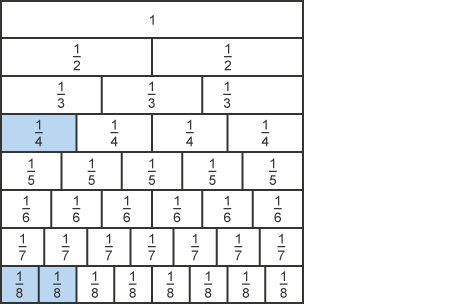Maths Fichas sobre Four rules with fractions, creado por Liffey Farrell el 13/05/2017.
Pineado a
22
1
0
Sin etiquetas
|
|
Creado por Liffey Farrell
hace más de 7 años
|
|
Cerrar
|
|
Creado por Liffey Farrell
hace más de 7 años
|
|

Using fractions:
Fractions show parts of whole numbers, for example, the fraction 1/4 shows a number that is 1 part out of 4, or a quarter

Fractions are one way of showing numbers that are parts of a whole. Other ways are decimals and percentages. You can also convert between fractions, decimals and percentages. Like whole numbers and decimals, fractions can be either positive or negative.
Equivalent fractions are made by multiplying or dividing the denominator and numerator of the fraction by the same number.

Multiplying or dividing both parts of a fraction by the same number will always create equivalent fractions. There are an infinite amount of equivalent fractions that can be found because there are an infinite amount of numbers to multiply by
For instance:
2/9 + 3/9 = 5/9 or 6/11 - 4/11 = 2/11
Example:
Work out 4/7 + 1/3
Create a common denominator by looking for the lowest common multiple of 7 and 3. This is 21 (7 x 3 = 21, 3 x 7 = 21)
Multiplying and dividing fractions:
- To multiply two fractions together, multiply the numerators together and multiply the denominators together.
6/15 can be simplified to 2/5 (take out a common factor of 3)
Example 2:
Work out 2 1/3 x 1 1/2
2 1/3 = 7/3 (2x3+1/3) and 1 1/2 = 3/2 (1x2+1/2)
7/2 = 3 1/2
Divide the numerator by the denominator
This fraction cannot be simplified any further, so this is the final answer
Example:
Work out 3/5 / 2/3
This is the same as 3/5 x 3/2 (keep the first fraction the same, change the divide sign t a multiply and write the second fraction as a reciprocal - flip it upside down)

 Ocultar las fichas que te sabes
Ocultar las fichas que te sabes